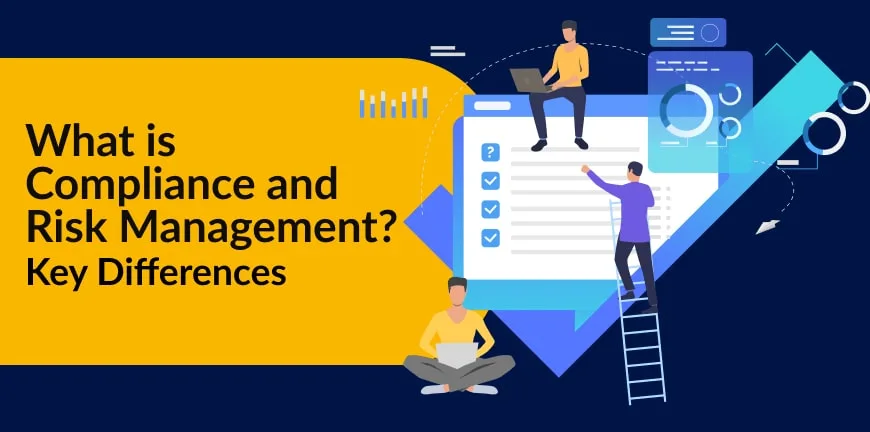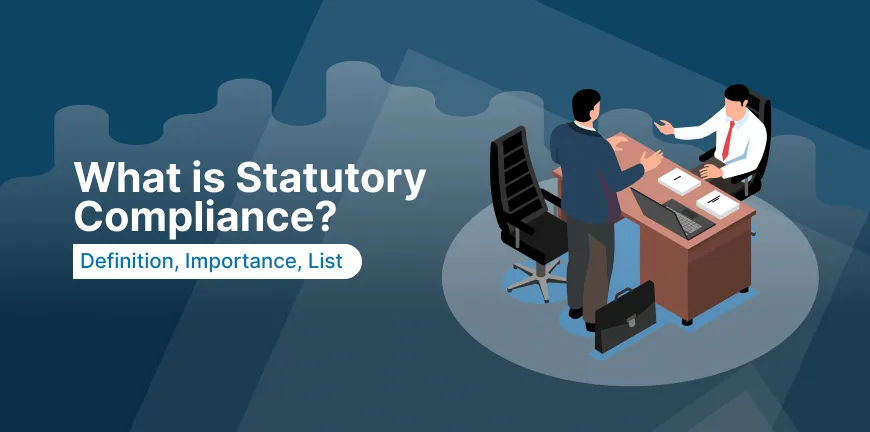
How to Get a Job in Japan from India?
01/05/2025
What is Candidate Sourcing: Definition, process, and examples
02/05/2025- What is Compliance Management?
- What is Risk Management?
- What are the Key Differences Between Compliance and Risk Management
- Why are both Compliance and Risk Management Important?
- What are the Benefits of Compliance and Risk Management?
- What are the Challenges in Implementing Compliance & Risk Management?
- What are the Best Practices for Effective Compliance & Risk Management?
- What are the Future Trends of Compliance and Risk Management?
- Frequently Asked Questions (FAQs)
The modern business landscape is a ‘warzone of survival’, and mitigating risks is a crucial winning strategy that can make or break a business entity. Compliance and risk management are two approaches that can help companies mitigate risks and achieve compliance with regulatory requirements simultaneously.
But, understanding the subtle difference between compliance and risk management is essential as both serve similar purposes of improving business practices, but follow different paths to achieve the same. Let’s break the ice and gain valuable insights related to compliance and risk management.
What is Compliance Management?
Compliance management is a closed-loop process of monitoring, evaluating and improving a company’s operations, policies, and procedures against the prescribed standards, regulations, and laws imposed by government agencies (both state and central governments).
Corporate compliance and regulatory compliance are two types of compliance management that companies must achieve to prevent legal hassles and penalties and maintain their brand reputation.
Both compliance and risk management go hand-in-hand and companies that succeed in both these aspects go a long way to becoming profitable and enhancing their brand reputation.
What is Risk Management?
Risk management is a strategic approach by companies to identify, assess and mitigate potential risks associated with legal, financial, security, and other areas of business. Proper risk management will lead to numerous growth opportunities that companies can leverage to improve productivity, and profitability, and enhance brand visibility across the business landscape. Risk management involves:
- Identification of potential threats that can hamper the progress of the company.
- Assessment of the impact of potential risks on the company’s current business operations.
- Prioritizing the risks to be eliminated based on the severity of the impact.
- Proactive response and mitigation of potential risks
- Implementing Continuous monitoring and control measures to actively make modifications to ensure the process runs seamlessly.
What are the Key Differences Between Compliance and Risk Management
The difference between risk management and compliance is subtle but both serve a similar purpose of streamlining business operations and help companies achieve positive outcomes in terms of compliance and prevent legal hassles. Here are the major differences between risk management and regulatory compliance.
| Aspect | Risk Management | Compliance |
| Focus | The main objective here is to identify, assess, and mitigate possible risks and fixing them in early stages. This approach helps in streamlining the business operations and procedures leading to better productivity and profitability. | The main objective here is to align company policies, operations and procedures with prescribed laws and regulations and ensuring 100% compliance is achieved. |
| Scope | It includes a broader range of risks like financial, operational, regulatory, strategic, and reputational risks. | It mainly covers regulatory risks ensuring company is adhering to rules and regulations imposed by government bodies. |
| Purpose | The risk management team ensure all potential risks and discrepancies are fixed on priority before it escalates and disrupts business operations | The compliance team ensure the legal and regulatory requirements are met to prevent penalties and lawsuits. |
| Approach | It involves development of proactive strategies like risk identification, assessment, mitigation and monitoring. | It involves in-depth understanding of compliance regulations and developing policies and procedures accordingly. The compliance team conducts periodic audits to assess and verify compliance and generate final audit report for the company to prove compliance with government agencies |
Why are both Compliance and Risk Management Important?
Legal compliance and risk management play a critical role in ensuring a company’s operations, policies, and procedures are in line with the laws and regulations of the government. However, adhering to rules and regulations doesn’t mean operational speed and productivity are sacrificed for quality. The internal audit compliance and risk management strategies should create a middle ground where operational efficiency is maximised, and legal compliance is achieved at the same time. A strong emphasis on risk management and regulatory compliance leads to,
- Better compliance with laws and regulations laid by government agencies.
- Enhanced brand reputation
- Mitigation of potential risks and discrepancies associated with policies procedures and operations.
- Better productivity and profitability
- Improved employee and stakeholder trust
- Gain a competitive edge over competitors with better operational efficiency.
What are the Benefits of Compliance and Risk Management?
The key benefits of enterprise risk management and compliance include:
1. Benefits of Risk Management
- It can save companies from incurring financial losses by mitigating risks at early stages.
- It leads to better compliance audit results, preventing penalties and lawsuits.
- It helps in reducing discrepancies in operations and aids in better planning.
- It demonstrates leadership and commitment towards creating a better work culture.
- It helps in enhancing brand reputation.
- It enhances employee productivity.
- It helps management make smart and informed decisions.
2. Benefits of Compliance Management
- It prevents penalties and legal hassles.
- It enhances transparency and trust among employees, stakeholders, and investors.
- It improves financial stability by mitigating risks and exposing financial fraud at an early stage.
- It increases operational efficiency and helps in better resource allocation.
- It helps companies stay up to date with the latest regulations and amendments.
- It minimises operational disruptions.
- It improves data security and management.
- It helps in driving automation initiatives leading to faster operations and higher productivity.
What are the Challenges in Implementing Compliance & Risk Management?
The key challenges associated with implementing robust compliance and risk management system are:
1. Navigating through complex and evolving regulatory frameworks
The compliance regulations are complex and vary based on the type of industry, product, jurisdictions, company size, etc. Also, the authorities make frequent changes and amendments to the existing regulations making it difficult for companies to modify their policies and procedures in a short duration.
2. Skill gaps and resource shortages
It is challenging to create a compliance and risk management team with in-depth knowledge of compliance requirements for different departments within the organisation. Ex: An expert in financial compliance may not have the skills to oversee compliance requirements related to the IT team.
3. Complexity in managing data
Companies must store different types of sensitive data across departments and present it to auditors during compliance assessment. This can be challenging when some data are stored electronically and some manually. Unless there is an automation process implemented to store all data from every department, discrepancies and errors are inevitable.
4. Employee awareness and training
Creating awareness of compliance and risk management among employees and managers can be challenging since it requires specialised expertise and experience in compliance. Employees and managers must undergo regular training on compliance and risk management which requires additional investment and constant monitoring which can increase overall expenses for companies.
5. Proving Compliance
For companies to prove 100% compliance, data records must not have a single inaccuracy which is a hard task to accomplish as keeping records of some tasks within the organisations may not be practically possible. Hence, proving compliance is a lot harder for companies with large workforce and numerous operational requirements.
What are the Best Practices for Effective Compliance & Risk Management?
The best practices for effective compliance and risk management are:
1. Create an integrated strategy
Legal compliance and risk management must be part of the company culture rather than treating it as a separate activity for the sake of preventing liabilities. By integrating compliance and risk management in every function, companies can mitigate risks early and streamline each operation to derive the best outcomes beneficial for all involved parties.
2. Involvement of the senior leadership group is key
As we know great work culture starts from the top. Companies must ensure that the senior leadership group is fully involved in compliance and risk management efforts. Once senior management is committed towards compliance, the employees will automatically follow their path to ensure all the policies and procedures are followed diligently and 100% compliance is achieved.
3. Embrace widely recognised frameworks
Companies must choose widely recognised regulatory frameworks like ISO 27001 to demonstrate commitment towards compliance and gain trust of employees and stakeholders. The internal audit compliance and risk management system can be built around these frameworks to get better results in terms of compliance and overall business success.
4. Leverage Technology
Companies must integrate the latest technologies like AI, automation, VR, AR, etc., into compliance and risk management to achieve better results in a shorter time.
5. Regular training for employees and managers
Companies should be committed to providing compliance awareness and training regularly to increase the success chance of achieving compliance and mitigate risks. Additionally, organisations must ensure the lessons learnt in the training sessions are implemented by employees in their regular tasks and feedback is recorded to verify the progress.
What are the Future Trends of Compliance and Risk Management?
The key future trends of compliance and risk management are:
1. Automation and AI in risk management
AI and Machine Learning continue to revolutionise compliance and risk management practices. In 2025, more organisations will integrate AI to monitor compliance in real time, automate risk assessments, and identify anomalies before they cause compliance issues.
2. Emphasis on ESG compliance
Environmental, Social, and Governance (ESG) compliance is no longer optional for companies. The regulatory agencies are emphasising ESG report submissions and non-compliance will lead to penalties and legal complications.
3. Cybersecurity as a bedrock for Risk management
As more and more companies go digital, cybersecurity threats have also become more rampant. Cybersecurity and risk management have strong interconnection and hence companies must create stringent cybersecurity protocols to mitigate and prevent cybersecurity threats at any early stage.
Frequently Asked Questions (FAQs)
1. What is the difference between compliance and risk management?
The difference between risk management and compliance is that compliance is concerned with company policies and procedures aligning with laws and regulations. On the other hand, risk management encompasses a broader process of identifying, assessing, mitigating, and monitoring potential risks associated with an organisation’s policies, procedures and day-to-day operations.
2. Can compliance be part of risk management?
Yes, compliance is a part of risk management as it involves mitigating risks associated with compliance regulations and laws.
3. Who is responsible for compliance and risk management in a company?
The senior management and internal compliance team are responsible for ensuring organisational policies and procedures are compliant with laws and regulations prescribed by respective government agencies.
4. What is compliance risk management?
Compliance risk management is an ongoing standardised process of identifying, assessing, mitigating and monitoring potential risks and discrepancies associated with an organisation’s policies, operations, and procedures.
5. How do compliance and risk management work together?
Compliance and risk management work together by considering compliance as the central part of risk management and fixing non-compliance issues proactively to mitigate risks and streamline all business operations and policies to meet regulatory requirements.
Contact Us For Business Enquiry

Hariharan Iyer
Hariharan Iyer is the Vice President – Operations at ALP Consulting, bringing over 40+ years of experience in HR outsourcing and labour law compliance. He leads end-to-end HRO operations, ensuring process efficiency, statutory compliance, and seamless service delivery for clients across industries. With a strong background in labour law governance and workforce management, Hariharan plays a key role in driving operational excellence and compliance-led HR solutions at ALP Consulting.




